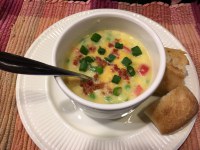Prairie Fare: Warm Yourself With Some Soup
(Click an image below to view a high-resolution image that can be downloaded)
By Julie Garden-Robinson, Food and Nutrition Specialist
NDSU Extension Service
“Mom, now my hands will smell like onions!” my older daughter said as she chopped a particularly fragrant onion we had grown this summer.
She has been my long-term vegetable chopper, even when we have gadgets that will do the work for us. We had onions, bell peppers and potatoes to chop as we tried this week’s recipe on a cool afternoon.
I was rinsing and chopping home-grown potatoes. Yes, I chose the easy vegetable to prepare. Next time, I think my daughter will be handing me an onion.
“Isn’t this supposed to have ham in it?” my daughter asked as she reread the recipe.
“This is a different recipe. It has peas in it, too,” I replied.
She looked at me strangely. I could read her mind. What kind of potato soup recipe was this, anyway?
She tasted it a couple of times and seasoned it with some extra pepper and salt. That’s the nice thing about cooking; you get to adjust it to your taste.
Soup is comforting, good-for-us food as we settle into colder outdoor temperatures in the upcoming months. It is high in liquid, so that means it usually is lower in calories than other foods. Vegetables are at least 90 percent water and, of course, water has no calories.
In fact, having a cup of broth-based soup before a meal can take the edge off your appetite. Vegetables and broth are high in volume but low in calories. According to Pennsylvania State research, using the concepts of “volumetrics,” having a serving of broth-based soup can reduce the amount of calories you consume in the main meal by 20 percent.
As I explored the type of soup to make out of the numerous options, I decided on potato soup because we had fresh potatoes, onions and chicken broth ready to be used. I just needed a red pepper.
Potatoes are among the best sources of potassium, a mineral that helps control blood pressure. Red bell peppers are an excellent source of vitamin C, which helps repair skin and blood vessels and helps wounds heal. Onions also are good sources of vitamin C, as well as disease-fighting phytochemicals (plant chemicals).
As part of an overall healthy lifestyle, eating more vegetables can reduce our risk for several chronic diseases, including diabetes, heart disease and cancer. Soup is an excellent way to incorporate more vegetables in your diet.
Yes, you can buy many types of canned soup, but homemade soup is preferred by my family and maybe yours. Who can resist the aroma of a simmering pot of your favorite soup and some fresh crusty bread or rolls?
You might still have fresh vegetables from a garden or farmers market. Perhaps you would like to make your own home-canned soup. If you do, be cautious.
First, keep in mind that food preservation requires special equipment and research-tested recipes. If you would like to make home-canned vegetable soup, a pressure canner and current processing directions are required for safety. See https://www.ag.ndsu.edu/food/food-preservation/can for more information about home canning.
A fairly recent botulism outbreak involved improperly home-canned potatoes. In 2015, one person died and 24 were hospitalized in Ohio after eating home-canned potatoes made into potato salad at a church potluck.
Vegetables and most mixtures of food must be pressure canned for safety unless they have added acid. Pressure canning brings the temperature to 240 degrees, which is high enough to inactivate the bacteria that can produce a deadly toxin in the air-free environment of a jar or can.
Water-bath canning is not safe for vegetables, so if you water-bath canned any potatoes, beans, carrots, corn or other vegetables, I have bad news for you. We do not consider them safe to use.
Improperly handled leftover baked potatoes also can become a food safety hazard. A foodborne illness outbreak in a food-service operation was associated with foil-wrapped baked potatoes left in a turned-off oven overnight. The potatoes were unwrapped and made into potato salad the next day.
To avoid the risk of foodborne illness, always remove the foil from baked potatoes before storing them, and place them in a refrigerator at 40 F or lower.
Enjoy some potatoes in this colorful, hearty soup recipe that can use fresh, canned or baked potatoes. The recipe is adapted from one provided by the Iowa State University “Spend Smart. Eat Smart” program.
Super Potato Soup
5 c. of cubed potatoes, boiled and drained (canned potatoes or leftover boiled, baked or mashed potatoes can be used)
1 1/2 Tbsp. butter
1 c. onion, chopped
1/2 c. red bell pepper, chopped
1 (14 1/2-ounce) can chicken broth, reduced sodium
1 c. nonfat milk (or more for a thinner soup)
1 c. frozen peas, thawed
1/2 tsp. ground black pepper
4 slices American cheese
Salt and additional pepper (to taste)
Optional garnishes (shredded cheese, sliced green onion, bacon bits)
Prepare potatoes. Melt butter in a large pot over medium heat. Stir in onion and red pepper and cook until softened. Stir in the broth and heat to a boil. Add milk, potatoes, peas, salt and pepper. Add cheese slices. Continue heating and stir about two minutes until cheese melts. Garnish each bowl with shredded cheese, sliced green onion and bacon bits as desired.
Makes six servings. Without added salt or garnishes, each serving has 250 calories, 9 grams (g) fat, 12 g protein, 33 g carbohydrate, 4 g fiber and 570 milligrams sodium.
(Julie Garden-Robinson, Ph.D., R.D., L.R.D., is a North Dakota State University Extension Service food and nutrition specialist and professor in the Department of Health, Nutrition and Exercise Sciences. Follow her on Twitter @jgardenrobinson)
NDSU Agriculture Communication - Nov. 2, 2017
| Source: | Julie Garden-Robinson, 701-231-7187, julie.garden-robinson@ndsu.edu |
|---|---|
| Editor: | Ellen Crawford, 701-231-5391, ellen.crawford@ndsu.edu |



